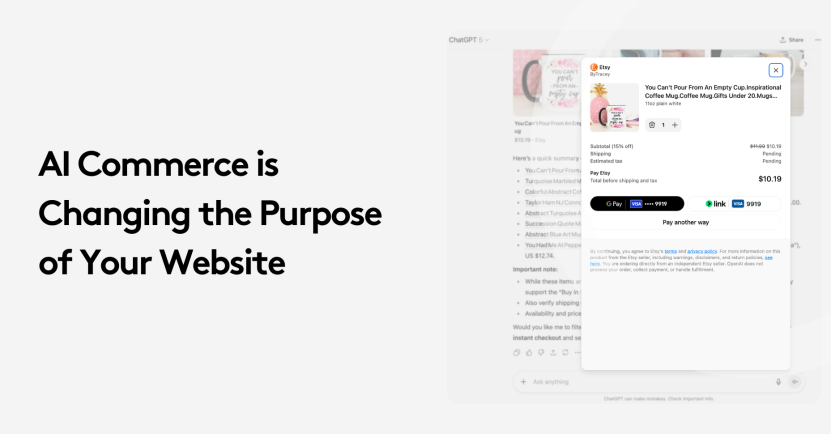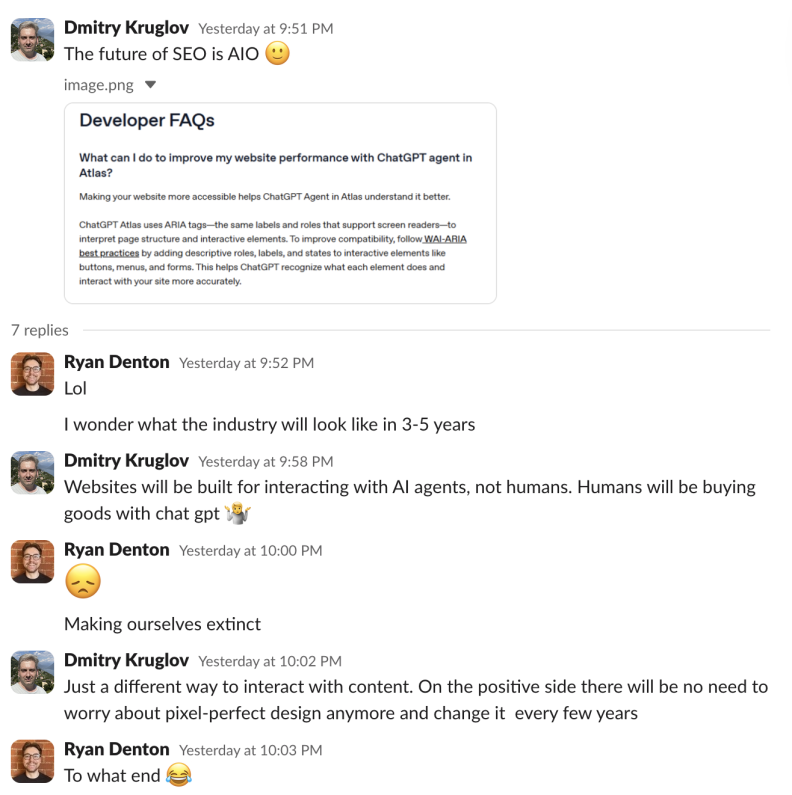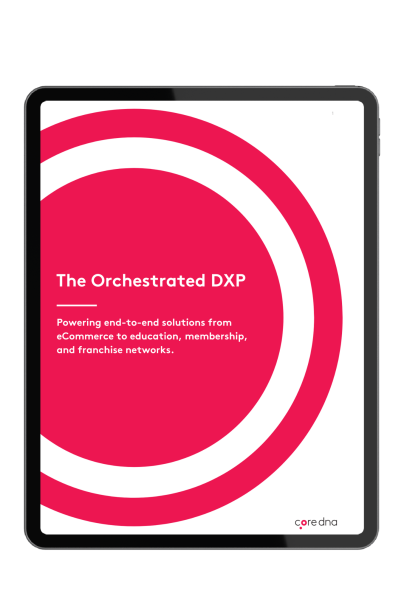AI Commerce is Changing the Purpose of Your Website

The retail battleground just shifted, again.
In the span of a few months, we’ve seen a chain reaction: Walmart’s October 2025 partnership with OpenAI brought in-chat shopping to millions of users; in the same month, OpenAI launched Instant Checkout, allowing users in the U.S. to buy from select vendors without ever leaving a chat.
Google followed with AP2, a shared protocol for secure, agent-led payments backed by PayPal, Mastercard, and American Express, and the newly introduced ChatGPT Atlas is showing how generative AI can organize, summarize, and reason across entire product ecosystems.
These events mark the moment AI commerce stopped being a theory and became a reality. In this world, it’s tempting for brands to say: “If the agent handles discovery and checkout, why do I need a website?”
And for most businesses, that realization raises a hard question: How do we adjust, and how fast?
After decades of investing in websites, platforms, and personalization engines, every digital leader now faces the same reality: your technology choices are about to be tested.
Can your current platform adapt to an AI-driven world or will you need to rebuild?
Key takeaways
- AI shopping is now real with Walmart, Google, and ChatGPT driving the shift from clicks to conversations.
- Over 700M ChatGPT users are researching, comparing, and buying directly in chat.
- Commerce has exploded into dozens of new channels where data quality matters more than website design.
- Orchestration makes businesses adaptable by separating business logic from interfaces. Websites still matter as hubs for trust, loyalty, and storytelling that AI can’t replace.
On this page:
AI Commerce Reality: From Clicks to Conversations
More than 700 million people now use ChatGPT weekly, and trust us, they’re not just chatting. They’re researching, comparing, reviewing, and transacting.
It’s no surprise adoption has been so fast. For most of us, it feels effortless. In one chat, we can compare products, ask follow-up questions, get recommendations, and read the entire internet in a neat summary.
What was missing was obvious and now it’s here: pay-all in one place.
For brands, though, this changes everything. These new channels expand reach but remove you from the center of the customer journey. We’ve seen it before with Amazon or other third-party platforms, you gain distribution but lose control.
But this time feels different.
Because LLMs don’t just show customers your products; they show them everything. They let shoppers compare across the entire internet: reviews, specs, competitors. And that pushes brands out of their comfort zone in ways we’ve never experienced before.
High-consideration purchases such as electronics, home goods, travel, are already shifting toward AI-assisted journeys. McKinsey estimates that by 2030, up to $5 trillion in global retail revenue could be orchestrated by AI agents but the keyword here is "AI-assisted"... stay with us.
AI Commerce and The Channel Explosion
We are definitely living in the era of convenience paradox. Every brand wants to “meet customers where they are.” The challenge is that “where they are” keeps multiplying
In 2015, a retailer needed to manage maybe five core digital channels: their website, email, a mobile app, a social presence, and an Amazon store.
Today, that number has ballooned into dozens of micro-channels, each with its own context, data format, and user journey:
- Conversational commerce (ChatGPT, Claude, Gemini)
- Voice interfaces (Alexa, Siri, in-car systems)
- Social commerce (Instagram, TikTok, Pinterest)
- Retail media networks (Walmart Connect, Amazon DSP)
- Owned assistants (brand-specific AI experiences)
- Emerging agent ecosystems (AP2, Agentic Commerce Protocols)
When AI agents handle discovery, search, comparison, and checkout, your visibility depends on how readable and trustworthy your data is, not how beautiful your site looks. The platform controls the dialogue, and you become a data provider in someone else’s conversation.
Each channel has unique expectations, some need natural language data, some need structured schemas, and some require direct API access to live stock levels.
The challenge isn’t participating in one of these, it’s orchestrating all of them without fragmenting your operations.
That’s why architecture now matters more than aesthetics. A beautiful front-end is meaningless if your systems can’t speak fluently to the environments where customers actually shop.
The AI Commerce adaptability Imperative
When every commerce surface becomes intelligent, adaptability becomes the defining competitive advantage.
The companies that will lead the AI commerce revolution aren’t necessarily the biggest or the oldest, they’re the ones whose systems can flex, integrate, and evolve at the speed of new interfaces.
That belief is what shaped our approach at Core dna. For the past couple of years, we’ve been re-engineering the platform around a single organizing principle: orchestration.
Orchestration isn’t a feature. It’s a architecture shift that moved us from building fixed systems to building systems that can think in relationships. Instead of treating each channel, integration, and front end as separate, orchestration connects everything through a living layer of logic that governs how data moves, how rules are applied, and how experiences adapt.
This is where adaptability becomes real. When your pricing logic, shipping rules, or personalization models live in an orchestration layer, they’re no longer bound to one website or one interface. They can extend across any channel, a conversational agent, a marketplace, or an AI assistant and still behave consistently.
That separation of intelligence from interface is the architectural breakthrough that will define the next decade of digital AI commerce. It gives businesses structural freedom:
- Freedom to plug into new ecosystems without rewriting code.
- Freedom to test new channels without operational risk.
- Freedom to evolve at the same pace as technology itself.
In many ways, orchestration future-proofs your entire digital stack. It turns adaptability into a native capability, not a project. It ensures that as commerce fragments across devices and AI agents, your business logic remains whole coherent, connected, and under your control.
This is why architecture now matters more than ever. The businesses that build on orchestrated foundations won’t just survive the AI commerce era; they’ll define it.
Can your eCommerce Platform Keep Up?
Most companies didn’t build their tech stacks for this.
They were optimized for a world where your website was the center of gravity, the one place where every product lived, every campaign pointed, and every transaction closed.
That made sense for the last 20 years. In a browser-based world, the website was the business. Every integration, plugin, and CMS extension existed to serve that singular destination. The measure of success was traffic, not adaptability.
But that logic is breaking.
Today, your website is just one node in a sprawling, AI-mediated ecosystem of commerce touchpoints: ChatGPT, Google Gemini, voice assistants, social storefronts, and soon, brand-specific AI agents embedded in everything from cars to TVs to wearable devices.
In this new landscape, your tech stack isn’t a website engine anymore, it’s a connectivity engine. Our internal discussions are fueling the debate :)

The businesses that thrive in this shift will be the ones that treat every new AI surface not as competition, but as an extension of their infrastructure. That requires more than plugging into new APIs; it means rethinking the purpose of your technology altogether.
No need to panic yet, we still got time.
I tried to test the famous instant checkout and let's just say it still needs some work. We still got time to adjust as they are adjusting.
When Legacy Systems Become Friction
Most existing eCommerce systems were built for the web era: platforms that manage front-end pages, handle cart logic, and store data in siloed databases.
But in the era of AI commerce, that architecture becomes friction.
AI agents need to query live inventory, confirm specifications, compare data across sources, and process transactions, all programmatically. They expect your systems to respond like another AI, not a human-driven website.
If your product data lives in multiple systems, if pricing updates require manual publishing, or if integrations rely on fragile middleware, you’re already losing speed. Each limitation becomes technical debt, the silent tax that compounds every day your infrastructure can’t adapt.
McKinsey’s 2024 research shows that enterprises with high-performing, modernized technology stacks generate up to 35% higher revenue growth than their peers. The takeaway is clear: modernization isn’t just a technical upgrade, it’s an economic multiplier. The ability to integrate, iterate, and adapt faster directly translates into top-line growth.
Why Your Website Will Always Matter: Lessons from "Buy-on-Google"
Even as the front lines of commerce shift toward AI agents and chat-based interfaces, one truth remains: your owned channels: your website, your app, your community, are still the foundation of lasting customer relationships.
Think of it this way: in the near future, many straightforward, high-volume transactions, subscriptions, repeat purchases, routine consumables, will increasingly happen via conversational agents, voice assistants, or embedded AI flows.
Meanwhile, big-decisions, brand-defining purchases, explorations, and loyalty-driven interactions will still route through your brand’s own domain, the place where your identity, values, and experience live.
A few years ago, Google tried to solve eCommerce’s biggest pain point: friction.
It launched “Buy on Google”, a program that let users purchase products directly from search results without ever visiting a retailer’s website. The logic seemed flawless—simplify checkout, speed up transactions, and keep shoppers inside Google’s ecosystem.
But in 2023, Google quietly shut the program down.
Despite removing fees and simplifying onboarding, few merchants adopted it. Even with Google’s brand trust, customers still preferred to check out on the retailer’s site.
Why? Because convenience wasn’t the real problem, confidence was.
Retailers didn’t want to lose control of their brand experience, upsells, and first-party data. Customers didn’t want to hand off service, warranties, and returns to an intermediary.
And running a parallel checkout created more complexity, not less, duplicating data, syncing inventory, managing taxes and fulfillment across two systems.
In short: even Google couldn’t replace the emotional and operational gravity of the owned channel.
This failure became a defining lesson for the future of AI commerce:
Discovery can happen anywhere, but trust still lives on your own site.
Today, we’re watching the same pattern play out again, but this time, it’s AI driving the shift. Large Language Models (LLMs) like ChatGPT, Gemini, and Claude are quickly becoming the new discovery layer of the internet. They summarize the web, compare products, and even initiate purchases.
And just like Google’s experiment, they’ll likely succeed in routine transactions, reordering pet food, buying printer ink, renewing a skincare subscription. These low-emotion, low-stakes purchases will increasingly be handled through AI agents for sheer convenience.
But for higher-consideration or emotionally driven purchases: furniture, fashion, wellness, travel, eg... customers will still want to experience the brand. They’ll use AI to assist, not replace, their decision.
That’s why ChatGPT Atlas is so interesting. Instead of trapping users inside the chat, it integrates AI directly into browsing. Users can navigate a brand’s site, ask contextual questions, compare models, and explore deeper without leaving the page. It’s not about replacing websites, it’s about making them smarter.
This hybrid behavior will define the next era of digital commerce:
- AI for convenience, handling quick, repeatable transactions.
- Owned experiences for connection, where storytelling, trust, and brand differentiation still win.
So while your customers’ journeys will increasingly start in AI interfaces, the ones that matter most will still end on your owned channels.
So the strategic posture isn’t “let the agent handle transactions, ignore the site."
It’s to let the agent understand your product data, integrate with your systems and drive transactions, and create on your website an experience the agent can't create; for example an immersive brand environment, meaningful content, community belonging, personalization anchored on your first-party data.
In short: owned channels still win, but only when you recognize the shift in behavior.
Routine, high-volume purchases may move to agents. But brand loyalty, trust, and differentiation continue to live on your direct channels—and ensuring those channels are compelling is your competitive advantage.
So What to Do When the Purpose of Your Website Is Changing
For two decades, your website was your storefront, your brand story, and your transaction engine all in one. But the rise of AI-mediated commerce is quietly separating those roles.
The goal now isn’t to fight that shift, it’s to redefine what your owned experience is for.
If your website’s purpose used to be to sell, its new purpose is to connect, convert, and continuously learn. It’s not about being the only place customers buy; it’s about being the place that gives every other channel meaning.
Here’s how to adapt as the purpose of your website evolves:
1. Turn your website into a brand system, not just a storefront.
Your site should express who you are, not just what you sell. Use it as the single source of truth for your brand’s identity, voice, and purpose, something AI agents can reference but never replicate.
2. Design for exploration, not just conversion.
If AI agents and marketplaces are handling the low-friction sales, your owned site becomes where customers come to learn, compare, and imagine. Invest in guides, configurators, immersive visuals, and content that deepens understanding and emotion.
3. Optimize your data for AI discovery.
Even as your website shifts in purpose, it still needs to be technically structured for AI readability. That means clean product data, structured metadata, transparent policies, and real-time updates so that agents represent your brand accurately across channels.
4. Make your site the heart of your customer intelligence.
Every visit, download, and interaction generates first-party data. Centralize it. Use it to feed personalization, refine content, and inform your orchestration systems. The more your owned experience learns, the more resilient it becomes.
5. Reimagine success metrics.
Stop measuring your website purely by checkout volume. Measure engagement depth, repeat visits, community participation, and the number of agent-assisted conversions it influences. The web’s new economy isn’t built on click but connections.
This shift doesn’t diminish the value of your site, it expands it.
Your website stops being a static endpoint and becomes a dynamic ecosystem: part showcase, part data engine, part brand anchor in a landscape of shifting interfaces.
When your technology supports that flexibility, your website isn’t left behind by AI commerce, it becomes the foundation that powers it.
The Human Edge That AI Can't Replicate
Convenience will always win the first click. But meaning wins the second.
AI agents can recommend products; they can’t create belonging.
They can summarize features; they can’t tell your story.
They can optimize for price; they can’t optimize for trust.
We’ve seen this cycle before.
A decade ago, growth hacking was the holy grail of B2B marketing. Outbound sequences, cold emails, and automated LinkedIn messages promised endless scale. For a while, it worked. Then, it stopped.
Today, people are saturated. Their inboxes are full. Their notifications never end. The response? A quiet but powerful shift back to human connection, micro-events, dinners, and curated peer gatherings where relationships grow through real conversation, not automation.
Look at what organizations like The Ortus Club have built: invitation-only experiences that connect executives through dialogue, not demos. They’re thriving because people crave authenticity in an age of noise.

The same shift is coming for commerce.
AI-driven channels like ChatGPT, Gemini, and others, will dominate low-friction transactions. They’ll make buying faster, easier, and more automated than ever. But the meaningful interactions, the ones that build loyalty, differentiation, and advocacy will still happen on your owned channels, where you can tell your story and foster real connection.
Your owned experiences are your version of the micro-event. They’re where customers stop scrolling, stay longer, and connect deeper.
Here’s how to make those experiences unmissable:
- Offer direct-only value.
Reward loyalty with exclusive benefits: early access, limited drops, concierge service. Give customers something the AI channels can’t. - Build community.
Create spaces where customers can connect with you and each other. Host Q&As, user forums, or brand clubs. People don’t just buy products, they join tribes. - Show your values.
Be transparent about sustainability, sourcing, and inclusivity. Make your principles part of the experience, visible, verifiable, and authentic. - Personalize with intention.
Use first-party data to make interactions feel remembered and relevant, not mechanical. - Excel post-purchase.
Follow up with care. Solve problems fast. Celebrate loyalty. Every great brand moment happens after the checkout.
When customers realize that buying directly means better care, faster resolution, and genuine connection, convenience alone won’t be enough to pull them away.
At Core dna, we see this as the next evolution of digital maturity: AI may drive the transaction, but humanity sustains the relationship. And in the long run, that’s what every enduring brand—B2B or B2C—is built on.
And always remember, no matter how advanced the tools become, you’re still selling to humans, not robots.





